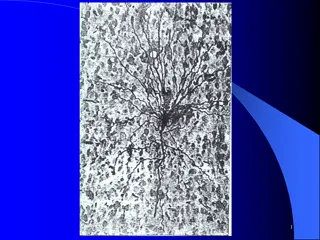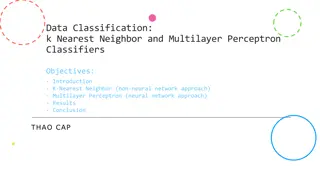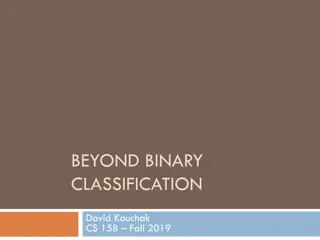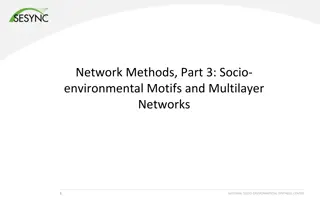Neural Network and Variational Autoencoders
The concepts of neural networks and variational autoencoders. Understand decision-making, knowledge representation, simplification using equations, activation functions, and the limitations of a single perceptron.
1 views • 28 slides
Introduction to Deep Learning: Neural Networks and Multilayer Perceptrons
Explore the fundamentals of neural networks, including artificial neurons and activation functions, in the context of deep learning. Learn about multilayer perceptrons and their role in forming decision regions for classification tasks. Understand forward propagation and backpropagation as essential
3 views • 74 slides
Understanding Perceptron Learning Algorithm in Neural Networks
Perceptron is the first neural network learning model introduced in the 1960s by Frank Rosenblatt. It follows a simple and limited (single-layer model) approach but shares basic concepts with multi-layer models. Perceptron is still used in some current applications, especially in large business prob
2 views • 54 slides
Understanding Perceptron Learning Algorithm in Neural Networks
Explore the concept of Perceptron Learning Algorithm and its application in Artificial Neural Networks. Learn about nodes, weights, thresholds, training techniques, and adjustments needed for accurate predictions.
1 views • 51 slides
NBA Defense Evaluation Using Machine Learning
Explore the attributes influencing NBA defensive effectiveness through a machine learning examination conducted by Alex Block Advisors, Chris Fernandes, and Nick Webb. The study analyzes various factors such as shooting percentage, turnovers, offensive rebounding, and free throws. Data from the 1996
0 views • 25 slides
Data Classification: K-Nearest Neighbor and Multilayer Perceptron Classifiers
This study explores the use of K-Nearest Neighbor (KNN) and Multilayer Perceptron (MLP) classifiers for data classification. The KNN algorithm estimates data point membership based on nearest neighbors, while MLP is a feedforward neural network with hidden layers. Parameter tuning and results analys
0 views • 9 slides
Understanding Advanced Classifiers and Neural Networks
This content explores the concept of advanced classifiers like Neural Networks which compose complex relationships through combining perceptrons. It delves into the workings of the classic perceptron and how modern neural networks use more complex decision functions. The visuals provided offer a cle
0 views • 26 slides
Understanding Artificial Neural Networks (ANN) and Perceptron in Machine Learning
Artificial Neural Networks (ANN) are a key component of machine learning, used for tasks like image recognition and natural language processing. The Perceptron model is a building block of ANNs, learning from data to make predictions. The LMS/Delta Rule is utilized to adjust model parameters during
0 views • 29 slides
Advanced Microscopy Techniques in EUV Lithography: SHARP Overview
SHARP utilizes Fresnel zone plate lenses to achieve diffraction-limited quality in EUV lithography, offering a range of NA values and image magnifications. The system allows emulation of mask-side imaging conditions with hundreds of lenses available. Coherence control and engineering are provided th
1 views • 18 slides
Understanding Multiclass Classification in Machine Learning
Explore the world of multiclass classification beyond binary models, covering real-world applications such as handwriting recognition and emotion analysis. Learn about current classifiers, k-Nearest Neighbor, Decision Tree learning, Perceptron learning, and the black box approach to multiclass probl
0 views • 74 slides
Understanding Recurrent Neural Networks: Fundamentals and Applications
Explore the realm of Recurrent Neural Networks (RNNs), including Long Short-Term Memory (LSTM) models and sequence-to-sequence architectures. Delve into backpropagation through time, vanishing/exploding gradients, and the importance of modeling sequences for various applications. Discover why RNNs o
0 views • 102 slides
Understanding Neural Networks for Machine Learning
Explore the learning process of linear neurons, why the perceptron learning procedure cannot be generalized to hidden layers, and the importance of iterative methods in solving complex problems in the context of neural networks. The content delves into the minimization of errors, the use of real-val
0 views • 34 slides
Optimization of Multilayer Perceptron Output with ReLU Activation Function Using MIP Approach
This research focuses on developing a systematic optimization model that incorporates a ReLU activation function-based neural network as input. The model generates a linear output that can be modeled as MILP and solved using a Mixed-Integer Programming approach. By producing scalable surrogate model
0 views • 7 slides
Understanding Kernels and Perceptrons: A Comprehensive Overview
Kernels and Perceptrons are fundamental concepts in machine learning. This overview covers the Perceptron algorithm, Kernel Perceptron, and Common Kernels, along with Duality and Computational properties. It also explores mapping to Hilbert space and the computational approaches for achieving desire
1 views • 40 slides
Overview of Linear Classifiers and Perceptron in Classification Models
Explore various linear classification models such as linear regression, logistic regression, and SVM loss. Understand the concept of multi-class classification, including multi-class perceptron and multi-class SVM. Delve into the specifics of the perceptron algorithm and its hinge loss, along with d
0 views • 51 slides
Exploring Socio-Environmental Motifs and Multilayer Networks
The content delves into socio-environmental motifs, anti-motifs, and multi-plex networks in the context of national socio-environmental synthesis centers. It uncovers the least likely and common occurrences in random networks, as well as common subnetworks underrepresented in the model of inquiry. T
0 views • 7 slides















